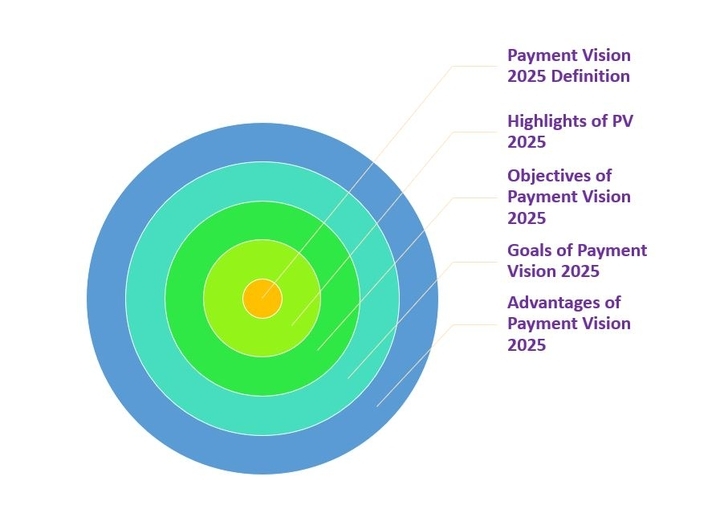Payments Vision 2025 In India: Know Complete Details Here
By BYJU'S Exam Prep
Updated on: September 25th, 2023

The journey of payment systems in India has been phenomenal in a recent couple of years. The Payments Vision 2025 promises to further elevate our payment systems towards a realm of empowering users with affordable payment options accessible anytime and anywhere with convenience. This is important to know the details for the upcoming bank exams in 2022.
As this journey towards a less-cash and less-card society unfolds, concomitant expansion in the basket of digital payment options with credence and confidence would ensure the sustenance of Reserve Bank’s approach of facilitating users with a seamless digital payment experience.
Table of content
Industry participants consider the Reserve Bank’s Payments Vision 2025 strategy, which aims to treble the volume of digital payments, to be progressive and has the potential to make India a global payments powerhouse. The RBI published its Payments Vision 2025 document, which emphasizes ring-fencing domestic payment networks and the need to ensure domestic processing of payment transactions, in response to growing geopolitical concerns.
This will also reinforce India’s position as the global leader in the digital payments domain. Considering the current geopolitical developments across the world, the Payments Vision 2025 document also seeks to address the potential risks arising out of any adverse situation that may arise.
 What is Payment Vision 2025?
What is Payment Vision 2025?
The text also discusses the necessity to compel domestic processing of financial transactions in light of the rising geopolitical threats, as well as the ring-fencing of domestic payment networks.
E-Payments for Everyone, Everywhere, Every time (4Es) is the overarching topic of the vision documents, with the general goal of giving every user access to safe, secure, quick, convenient, affordable, and convenient e-payment choices.\
Highlights of Payment Vision 2025
To regulate online payment aggregators and payment intermediaries and bring them all under the supervision of the RBI.
- Be aware of the expenses incurred in offering digital payment services, and assess them to make sure they do not prevent the adoption of digital payment systems.
- To ensure the security of the transactions, review the various PPIs (Prepaid Payment Instruments) and offer pertinent advice.
- With the goal of offering safer and more transparent payment solutions, emphasis is placed on developing authentication procedures for financial transactions.
Payment Vision 2025 Objectives
To improve the payment systems so that they can provide consumers with convenient, cost-effective payment choices that are available whenever and wherever they choose.
- To make it possible to geotag digital payment infrastructure and transactions, as well as to review the rules for prepaid payment instruments (PPIs), including closed system PPIs.
- Regulating all main payment ecosystem intermediaries and connecting UPI to credit cards and financial products credit components.
- To improve the Cheque Truncation System (CTS), including the clearing and settlement perspective of One Nation One Grid, and the development of a payment system for processing online merchant payments via internet and mobile banking.
- BigTech and FinTech regulation in the payments sector.
- BNPL (Book Now Pay Later) payment mechanisms are examined, and relevant rules for BNPL payments are investigated.
Payment Vision 2025 Goals
A threefold increase in digital payment transactions. UPI will rise by an average yearly 50% whereas IMPS/NEFT will grow by 20%.
- An increase in payment transaction volume relative to GDP of 8. 20 percent more debit card transactions at the point of sale.
- Less than 0.25 percent of all retail payments are made using checks, on average. The use of debit cards will eventually outpace that of credit cards.
- PPI transactions have increased by 150 percent. Infrastructure for accepting cards will grow to 250 lakh.
- 50 percent CAGR growth in the number of customers who have enrolled for mobile-based transactions. Cash in circulation (CIC) decline is expressed as a proportion of GDP.
Advantages of Payment Vision 2025
Debit card usage is anticipated to outpace credit card usage in terms of value, and card acceptance infrastructure is anticipated to grow to 2.5 crores.
- Additionally, the amount of cash in circulation (CIC) as a percentage of GDP would decline.
- The National Electronic Funds Transfer (NEFT) system is currently run in batches at half-hourly intervals throughout the day and is accessible throughout the entire year.
- The predicted outcome for UPI payments is a rise of 50% on an annualized basis, whereas for IMPS/NEFT transactions it is a 20% increase.
- Expected outcomes for additional payment methods including debit and credit cards are listed in the vision document.
- One of the goals is to work toward increasing debit card usage relative to credit card usage, which could reduce the likelihood of bad debts. The result is anticipated to be a 20% rise in debit card usage at the point of sale.
- The expansion of digital payment possibilities for both feature phones and smartphones is one of the many efforts included in the vision plan.
- It is anticipated that involving major IT businesses and fostering innovation will open the door for answers to these problems.
Download Payment Vision 2025 Detailed PDF
If you are aiming to clear the IBPS RRB exam in 2022, then join the Online Classroom Program where you will get:



